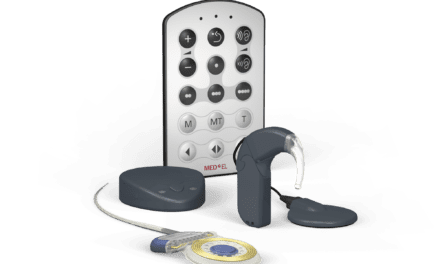 |
|
Gamma-actin patches (green) of gaps in steriocilia core (red). |
Excessive exposure to loud noise can have a devastating effect on the sensory cells in your inner ear, causing the stereocilia—the normally upright filaments sprouting from their tops—to be sheared off at the tip, to droop like a dehydrated daffodil, or to be wiped out entirely, depending on the noise level, according to a new study outlined in a statement from the National Institute on Deafness and Other Communication Disorders (NIDCD), Washington.
The study of a knock-out animal model provides fresh insights into how noise damages the inner ear and how that damage can be repaired, the statement says. The study, published in the June 3 early edition of the Proceedings of the National Academy of Sciences, was conducted by scientists from the NIDCD, the University of Minnesota, Michigan State University, the University of Kentucky, and Boys Town National Research Hospital in Omaha, Neb.
 |
|
An auditory steriocilia bundle from normal (top) and from gamma-actin-deficient (bottom) mouse. |
Inna Belyantseva, MD, PhD, of NIDCD’s Laboratory of Molecular Genetics, together with lab chief Thomas Friedman, PhD, University of Minnesota researchers James Ervasti, PhD, and Benjamin Perrin, PhD, Michigan State researcher Karen Friderici, PhD, and others found that when mice and guinea pigs are exposed to excessive sounds, a peculiar disruption of the center—or core—of a stereocilium will occur. Stereocilia are the site at which sound vibrations are converted into signals that travel to the brain, and they have a very precise architecture to sense sound. One of the early signs of damage due to excessive sound is the disruption of the stereocilia core into segments. These disruptions, or gaps, form in the stereocilia like giant potholes in a city street. If left unrepaired, the gaps can continue to grow, further degrading the stereocilia, and leading to permanent hearing loss.
The team was surprised to learn that gamma-actin helps fill in these gaps caused by excessive noise levels, while a second closely related protein, beta-actin, is responsible for building the structures in the first place, according to the NIDCD’s statement. Furthermore, they found that in the absence of gamma-actin, beta-actin does not efficiently repair or prevent further damage to the stereocilia, rather like filling a pothole with quicksand.
How the scientists arrived at these findings was perhaps an even bigger surprise: the team was able to develop a mouse in which the gamma-actin gene was knocked out, so it was unable to produce the protein, says the NIDCD in the statement. Scientists have known that mutations of this gene cause progressive hearing loss in people and other mammals. However, because gamma-actin is found in all cells of the body, many in the scientific community thought that an animal lacking the protein would not be able to survive. The researchers found that not only did some of the knock-out mice live, but they were able to hear as well as their normal counterparts at 6weeks of age, when the hearing ability of a mouse is considered to be fully matured. However, after 16 weeks, the gamma-actin knock-out mice began to show significant hearing loss, and after 24 weeks, they were profoundly deaf.
By using antibodies that label beta- and gamma-actin proteins a bright green in contrast to the red-stained stereocilia core, the researchers were able to show that in normal mice, beta-actin is located throughout the filament while gamma-actin is concentrated along the edges. In addition, beta-actin is present early in embryonic development of the inner ear, but gamma-actin shows up much later. These findings led them to conclude that the two proteins have different purposes.
Next, the team noticed that normal mice sometimes showed gaps in the cores of the long, threadlike stereocilia that detect balance elsewhere in the inner ear. However they saw no such gaps in the shorter stereocilia that detect hearing in normal mice. The results reminded them of another research team’s paper in which scientists had seen gaps in the auditory stereocilia of guinea pigs, but only after they had been exposed to loud noise levels. The team replicated that experiment, exposing guinea pigs to loud noise, but went one step further by staining the stereocilia with gamma-actin antibodies. They found that the filaments were stained red with intermittent gaps showing up bright green in color, indicating that noise had caused the gaps to form and that gamma-actin was filling in the gaps. Interestingly, the team also found that in the knock-out mice, gaps were present in auditory stereocilia even without experimental exposure to noise, emphasizing the importance of gamma-actin in maintaining the structure of the stereocilia against everyday wear and tear.
Finally, the researchers used electron microscopy to compare the size and shape of the stereocilia of normal mice to that of the knock-out mice. Until the mice were 6 weeks of age, the stereocilia of the gamma-actin-deficient mice looked similar to the normal mice. But as time progressed, the stereocilia in the deficient mice began to undergo unique changes; they shortened one by one in a random way as compared to the well-preserved uniform patterns exhibited by normal mice.
In humans, mutations of the gamma-actin gene cause a form of rapidly progressive hearing loss that’s known in scientific circles as DFNA20, according to the NIDCD. Because noise is a major contributing factor to age-related hearing loss, the researchers now wonder if people who have a subtle variant of this gene might be more at risk for developing age-related hearing loss, since damaged stereocilia may be repaired at a slower, less optimal rate.
[Source: NIDCD]




